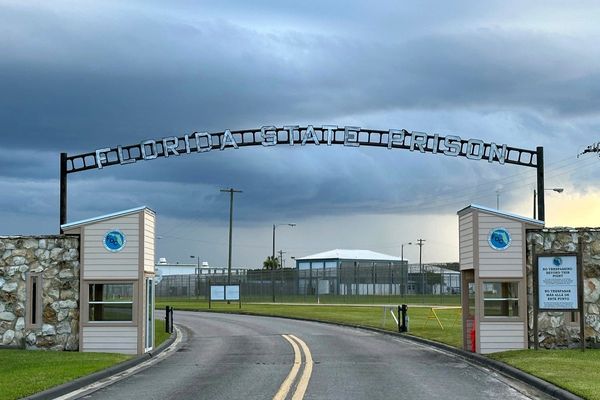
In the next few weeks, Jeff Glasbrenner, a 49-year old amputee and father of two, will strap on a harness—“kind of like a backpack without a backpack”—and begin dragging a 20-pound SUV tire around his neighborhood just outside Little Rock, Arkansas. He will drag his tire for anywhere from two to 10 hours a day, powered by a playlist of Counting Crows and Goo Goo Dolls; then, after a few weeks, he’ll start dragging two tires, and later, three. This mind-numbingly boring and difficult enterprise is meant to simulate, in certain ways, the act of pulling a sled across the jagged surface of the North Pole.
Glasbrenner, a three-time Paralympian, hopes to make the trip in April 2023, as the capstone of his long adventuring career and to further challenge people’s preconceptions about disability. But the hardest test of his endurance to this point has been the waiting. The coming winter full of tire-dragging will be Glasbrenner’s fifth; in prior years he’s had to scrap his plans to reach the Pole because of COVID, or on account of a confusing dispute involving arctic airplane pilots. “The whole time you’re like, ‘All right, it’s gonna happen, it’s gonna happen,’” he told me. “And then, you know, it doesn’t happen.”
The truth is, it may not happen this year either, or next year, or the year after that. In fact, the very future of adventuring at one of humanity’s greatest natural testing grounds is now in doubt. Although tourists seeking to clink glasses of champagne at the North Pole might still secure a seat on a nuclear icebreaker during the summer, modern adventurers hoping to spend significant time on the ice must pass through Barneo, a temporary camp built on a drifting ice floe in the Arctic Ocean. But that camp has been impossible to operate for half a decade now, and its future is uncertain. For Glasbrenner, as for the hundreds of others who attempt to make this trek each year in early April, the tip of the Earth has never seemed so far away.
Global warming is one problem: With the Arctic heating up four times faster than the global average, large ice floes are more vulnerable to breaking. In 2018, Barneo lasted a mere 12 days before cracks in the ice forced its closure. But the most pressing problems at the moment are political. The camp’s very existence is a testament to Russian technology and expertise, Francesco Annibali, Barneo’s CEO, told me, and sanctions against Russia, along with other ripple effects from the war in Ukraine, have prevented it from taking shape. This past March, Annibali had to cancel the polar season for the fourth year in a row, due in part to a ban on Russian planes in Norwegian airspace that was implemented days after the war broke out. Annibali is doing everything he can to de-Russify the operation—he’s now leasing a Soviet-era transport plane from Kazakhstan instead of Russia, for example—but it may not be enough. Despite these efforts, the status of the 2023 season is uncertain.
Barneo has existed as a commercial tourist enterprise for more than 20 years, yet it is based on a legacy of Soviet scientific drift camps in the Arctic Circle dating back to Stalin’s time. The Soviets launched the first camp, North Pole 1, in 1937 and continued the practice for decades after; scientists have sometimes spent more than a year afloat in the Arctic Sea. The Russians have turned the creation of floating-ice camps into a science of its own, and developed highly specialized equipment. First, a suitably solid ice floe must be identified from the air; next, pilots flying an Ilyushin Il-76—a Soviet-era military cargo plane built for arctic weather conditions—will lower 50 tons of equipment, including two hybrid tractor-bulldozers, onto the moving ice; finally, a 20-person logistics team spends five days on the floe constructing an airplane runway, a miniature tent city, and a kitchen. All of this happens under intense time pressure: Barneo can exist for about three weeks in April, the brief period just after the spring equinox when the 24-hour polar darkness has lifted but the ice is still strong enough to support a team of athletes and their 120-pound sleds.
The camp was in Russian hands until 2018, when Frederik Paulsen, a Swedish pharmaceutical billionaire whose esoteric interests include polar exploration, purchased it from the widow of Barneo’s founder, Alexander Orlov. Since then, the ice camp has failed to materialize even once. The 2019 polar season was canceled when the Ukrainian pilots hired to fly Barneo’s clients to the Pole either refused to work with or were banned from collaborating with the Russians responsible for building and administering the camp. (Glasbrenner was among the hundreds of adventurers from around the world already gathered in the northern-Norwegian town of Longyearbyen when the season was canceled.) In 2020 and 2021, Norway’s strict pandemic-entry restrictions kept Barneo closed. Then came the war.
For the camp to run in 2023, Barneo must comply with a growing list of restrictions on business dealings with the Russians. “They are recognized worldwide as the best in paradropping in remote-area operations,” Annibali told me when we spoke by video call last month. Workarounds are sometimes possible: When the company realized it needed to replace the toilet on its Antonov AN-74—a Soviet-era transport plane built to withstand arctic conditions—it managed to source one from a collector in the United States. But other problems are not so easily negotiated, Annibali said. “Sometimes there is only one company available for certain types of work and really you don’t have a choice.”
The need to disassociate from Russia has spurred a miniature version of the space race; the company’s new owners are scrambling to make up ground in one of the few remaining realms where the Russians can still claim global dominance. Barneo would like to replace its Russian MI8 helicopters with American-made Chinooks, and is hoping to swap out its Antonov AN-74 for a $26 million Airbus C. Even if Annibali can move away from using Russian equipment, though, he might still be beholden to the Russian paratroopers who remain, for the moment, uniquely capable of building a floating ice base. To address the concern, he has been looking at a place between Finland and Sweden where, he said, ice conditions are very similar to those at the North Pole, and where he might create a training camp for floating-ice-base-building paratroopers who aren’t Russian.
Even the camp’s title—an ironic Russian transliteration of Borneo, the tropical island in Indonesia—will have to be replaced. “The final touch will be the name, the branding,” Annibali said. “Otherwise, as soon as you say ‘Barneo,’ it’s, ‘Oh, the Russian camp!’ Bloody hell, it’s the North Pole. It’s not Russian. It’s not Swedish. It’s international. It belongs to all of us.”
If the North Pole belongs to us, then we’re responsible for keeping it accessible, even in the face of global politics and global warming. Glasbrenner’s guide, the Polar explorer Eric Larsen, worries for the future. Aside from Glasbrenner, he has three other clients who have paid $50,000 each for a 10-day “last degree” ski expedition, and, like Glasbrenner, those clients have each been waiting for nearly five years to test their limits. Larsen tries to stay optimistic, but he fears that the Pole could end up permanently out of reach, at least for anyone who isn’t willing to put themselves “in a monumentally risky situation.”
“There are so many variables,” Larsen told me. “You’re landing a huge plane on the Arctic Ocean sea ice in the middle of nowhere. You can have all the best intentions, the best equipment, the best knowledge.” But ultimately, your path to the Pole will be open or it will be shut. “There’s no question there is sort of a ticking clock on all of this.”







